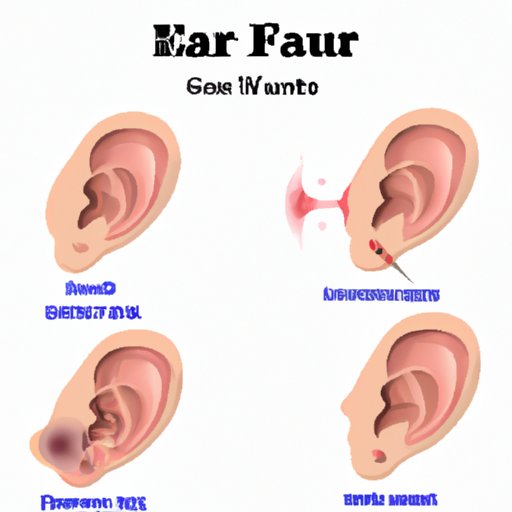What’s Causing My Right Ear Pain?
Right ear pain can be a frustrating and uncomfortable experience, but it’s a common health issue that affects people of all ages. While it’s essential to receive a diagnosis from a healthcare professional, understanding the possible causes, remedies, and prevention measures can be helpful. This article aims to guide readers on the causes of right ear pain, including ear infections, foreign objects, and Eustachian tube dysfunction. We’ll also provide tips on home remedies and over-the-counter medication for mild ear pain.
Guide on Possible Causes and Remedies
Ear infections are a common cause of ear pain in children but can also affect adults. There are three types of ear infections that can lead to right ear pain, including:
- Inner ear infection (otitis interna)
- Middle ear infection (otitis media)
- Outer ear infection (otitis externa or swimmer’s ear)
Each type of infection has its symptoms and treatment options, so it’s vital to receive a professional diagnosis. Some of the common treatments for ear infections include antibiotics, antiviral medication, and ear drops.
Foreign objects in the ear, such as insects, small toys, and food particles, can cause ear pain. If the object remains lodged in the ear, it can lead to severe pain and damage to the ear canal or eardrum. In some cases, removing the object can be a simple process, but it’s essential to seek medical help immediately.
Another potential cause of right ear pain is Eustachian tube dysfunction. The Eustachian tube runs from the middle ear to the back of the throat, and this tube is responsible for equalizing the air pressure in the middle ear. When the Eustachian tube is blocked, it can cause pressure changes, leading to ear pain and discomfort. Some self-care tips for Eustachian tube dysfunction include chewing gum, yawning, and swallowing to help equalize the pressure.
Home remedies for right ear pain can also provide relief for mild cases. Using a warm compress, such as a warm towel or heating pad, can help reduce pain and inflammation. Ear drops, such as olive oil or hydrogen peroxide, may also help by breaking down earwax or treating mild infections. However, it’s essential to check with a healthcare professional before using any home remedies.
Over-the-counter medications can also provide relief for mild ear pain, including pain relievers like acetaminophen or ibuprofen. However, it’s crucial to follow the dosing instructions and not to exceed recommended doses. Some over-the-counter ear drops can also help reduce pain or treat mild infections. Again, it’s essential to check with a healthcare professional before using any medications.
Personal Narrative of Right Ear Pain
As a child, I frequently experienced ear infections that caused a significant amount of pain in my right ear. I remember feeling as though my ear was under a great deal of pressure and not being able to hear correctly. As I grew older, I continued to experience occasional ear pain related to Eustachian tube dysfunction.
Over the years, I’ve tried several remedies to alleviate the pain, including using warm compresses and trying over-the-counter ear drops. However, I’ve found that getting plenty of rest and staying hydrated seems to be the most effective remedy for me. It’s essential to note that what works for one person might not work for another, so seeking professional advice is critical.
The Anatomy and Physiology of the Ear
Understanding the structure and function of different parts of the ear can help explain why certain issues with these parts can cause right ear pain. The ear has three main components: the outer, middle, and inner ear. The outer ear, consisting of the pinna and the ear canal, collects and channels sound waves towards the middle ear. The middle ear contains the eardrum and three small bones called ossicles that amplify sound waves, sending them to the inner ear. The inner ear includes the cochlea, responsible for converting sound waves into electrical signals the brain can interpret.
Issues with any of these parts, from an infection in the ear canal to damage to the inner ear from loud noises, can cause ear pain. Understanding the ear’s anatomy and physiology can help individuals take steps to protect their ears and reduce the risk of developing right ear pain.
Complications from Chronic Right Ear Pain
Ignoring persistent right ear pain can lead to further health complications, such as hearing loss, in some individuals. It’s critical to seek medical attention if the pain continues or becomes more severe. In some cases, ear damage can become permanent if left untreated, so it’s essential to take ear pain seriously and seek professional advice.
Preventative Measures
Taking preventative measures can help reduce the risk of developing right ear pain. Simple activities such as maintaining ear hygiene, avoiding sticking objects into the ear canal, and protecting the ears during loud activities such as concerts or fireworks can all help reduce the risk of ear pain. If you experience frequent ear pain, you may want to consult a healthcare professional to check for underlying problems.
Conclusion
Right ear pain can be a frustrating experience, but understanding the possible causes and prevention measures can help reduce the risk of developing pain or complications. Seeking professional advice and treatment is essential to prevent injury or permanent damage to the ear. By taking steps to protect your ears and implementing preventative measures, you can reduce the risk of developing right ear pain and protect your hearing.
